Features: Flower Shows |  |
The RHS Chelsea Flower Show 2005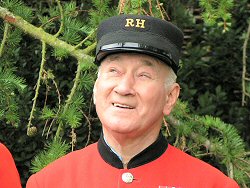 A Cheslea Pensioner soaks up the atmosphere. A Cheslea Pensioner soaks up the atmosphere. The Chelsea Flower Show is considered to be the event of the horticultural calendar The Chelsea Flower Show is considered to be the event of the horticultural calendar The Chelsea Flower Show is considered to be the event of the horticultural calendar. The 2004 Show included a great deal of interest to the wildlife gardener, though I remarked at the time that I thought that, in general, biodiversity and 'green' issues were still not at the forefront of the RHS' agenda. Again, in 2005, the RHS kindly provided SpaceForNature with a press pass so I was able to attend and see how, and if, things had moved on. There was a good deal of publicity before the 2005 Chelsea Flower Show about the various wildlife-friendly and green gardens that were going to be exhibited; would it live up to the billing? The Chelsea Flower Show is considered to be the event of the horticultural calendar. The 2004 Show included a great deal of interest to the wildlife gardener, though I remarked at the time that I thought that, in general, biodiversity and 'green' issues were still not at the forefront of the RHS' agenda. Again, in 2005, the RHS kindly provided SpaceForNature with a press pass so I was able to attend and see how, and if, things had moved on. There was a good deal of publicity before the 2005 Chelsea Flower Show about the various wildlife-friendly and green gardens that were going to be exhibited; would it live up to the billing?
The smaller gardens
I always feel sorry for the designers of the smaller format gardens at these flower shows; the space they have to work with really is tiny - much smaller in reality than it appears on TV and just a fraction of the space available to the 'show gardens'.
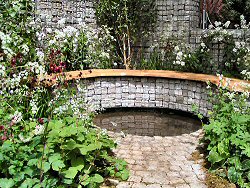 The Urban Glade city garden showing set-filled gabions. (View bigger image.)
Despite this, the designers do a remarkable job of packing features into their small plots. There were four small garden categories at the show: chic, city, courtyard and sunflower street. In the main, these are stylistic categories and by definition, The Urban Glade city garden showing set-filled gabions. (View bigger image.)
Despite this, the designers do a remarkable job of packing features into their small plots. There were four small garden categories at the show: chic, city, courtyard and sunflower street. In the main, these are stylistic categories and by definition,  the 'courtyard gardens' are more likely to be wildlife-friendly than the others which are more contemporary in nature the 'courtyard gardens' are more likely to be wildlife-friendly than the others which are more contemporary in nature the 'courtyard gardens' are more likely to be wildlife-friendly than the others which are more contemporary in nature. One of the city gardens did catch my eye however: the Urban Glade (bronze medal) was stylish and yet incorporated naturalistic planting including cow parsley (Anthriscus sylvestris). It also made a feature of set-filled gabions that might provide opportunities for invertebrates (though the close-fitting of the sets would limit this as a wildlife feature). the 'courtyard gardens' are more likely to be wildlife-friendly than the others which are more contemporary in nature. One of the city gardens did catch my eye however: the Urban Glade (bronze medal) was stylish and yet incorporated naturalistic planting including cow parsley (Anthriscus sylvestris). It also made a feature of set-filled gabions that might provide opportunities for invertebrates (though the close-fitting of the sets would limit this as a wildlife feature).
The Beyond the Pale courtyard garden (silver medal) also used gabions, but this time they were pebble filled.  The idea of gabions is a few years old now and the designers seem to have moved on to trying to outdo each other in terms of what they put in them! The idea of gabions is a few years old now and the designers seem to have moved on to trying to outdo each other in terms of what they put in them! The idea of gabions is a few years old now and the designers seem to have moved on to trying to outdo each other in terms of what they put in them! I liked the pebble-filled ones though, they were attractive and, as with all filled gabions, there is the potential for them to be a habitat for invertebrates. The idea of gabions is a few years old now and the designers seem to have moved on to trying to outdo each other in terms of what they put in them! I liked the pebble-filled ones though, they were attractive and, as with all filled gabions, there is the potential for them to be a habitat for invertebrates.
There was a predominant theme of naturalistic planting in the courtyard gardens. Over the Hills and Far Away, subtitled The Essence of the Kentish Countryside, (bronze medal) was probably the most naturalistic of the lot and incorporated a lot of native planting. However I felt it was rather over-designed and would be a very high-maintenance garden. The Shady Courtyard (silver-gilt medal) was a great little example of a cottage-style garden which would welcome wildlife. Despite a heavy reliance on hard landscaping, The Cumbrian Fellside Garden (gold medal and best courtyard garden) had a very relaxed and naturalistic ambiance, including native planting. It is noticeable that  whenever children are given the chance to contribute to the design of a garden, wildlife attracting features invariably figure prominently whenever children are given the chance to contribute to the design of a garden, wildlife attracting features invariably figure prominently whenever children are given the chance to contribute to the design of a garden, wildlife attracting features invariably figure prominently. Round and Round the Garden (bronze medal) was no exception. Designed, in part, by children from Sheddingdean Primary school, this was probably the courtyard garden which made most of its intent to attract wildlife; including a number of classic wildlife gardening features like a log pile, bird bath and bird nestbox. whenever children are given the chance to contribute to the design of a garden, wildlife attracting features invariably figure prominently. Round and Round the Garden (bronze medal) was no exception. Designed, in part, by children from Sheddingdean Primary school, this was probably the courtyard garden which made most of its intent to attract wildlife; including a number of classic wildlife gardening features like a log pile, bird bath and bird nestbox. Pictures of the courtyard gardens These pictures give a taste of some of the smaller gardens on display at the show. A feature of all of those shown here was the naturalistic planting. 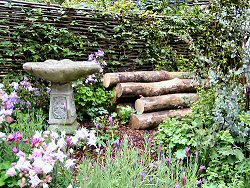 | | The charming Round and Round the Garden showing some of the many wildlife features. (View bigger image.) |
| |
| 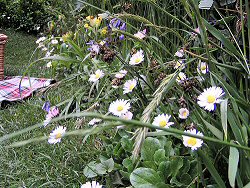 | | Naturalistic planting at a hedge base in the Over the Hills and Far Away garden. (View bigger image.) |
|
The Ecover Chelsea Pensioners Garden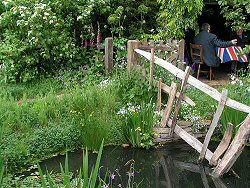 Looking as though it might have been there for centuries: the Chelsea Pensioner's Garden. (View bigger image.) Looking as though it might have been there for centuries: the Chelsea Pensioner's Garden. (View bigger image.)
This was the first time in the history of the Chelsea Flower Show that the Royal Hospital Chelsea (in whose grounds the show is staged), has had its own show garden. The garden was designed by Julian Dowle (who has become well known for his naturalistic gardens) with considerable input from Chelsea Pensioners themselves.  Nostalgic, picturesque and relaxing; this garden deserved accolades and got them aplenty Nostalgic, picturesque and relaxing; this garden deserved accolades and got them aplenty Nostalgic, picturesque and relaxing; this garden deserved accolades and got them aplenty - a gold medal, best show garden and BBC people's choice! Nostalgic, picturesque and relaxing; this garden deserved accolades and got them aplenty - a gold medal, best show garden and BBC people's choice!
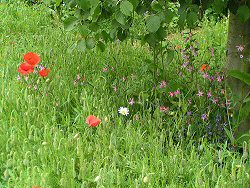 Naturalistic native planting in the Chelsea Pensioners Garden. (View bigger image.) Naturalistic native planting in the Chelsea Pensioners Garden. (View bigger image.)
This ambitious garden incorporated, at one end, a traditional thatched pub. The garden itself included a vegetable patch, cottage style planting as well as ample naturalist areas with plenty of native planting. Like several other gardens at Chelsea An excellent wildlife pond completed the picture. If this is an accurate reflection of gardens of 60 years ago, then it must have been a golden age for garden wildlife! In fact  the garden represented the dreams and aspirations of the soldiers away fighting for their homeland the garden represented the dreams and aspirations of the soldiers away fighting for their homeland the garden represented the dreams and aspirations of the soldiers away fighting for their homeland: an idealised view of a British country garden. the garden represented the dreams and aspirations of the soldiers away fighting for their homeland: an idealised view of a British country garden.
But  this garden was a wildlife haven without even trying to be this garden was a wildlife haven without even trying to be this garden was a wildlife haven without even trying to be, and that is something which we may have lost in these days of 'contemporary' and 'chic' design trends. It is encouraging to see that the relaxed and informal idiom of this garden proved to be so popular with the RHS and with the public. this garden was a wildlife haven without even trying to be, and that is something which we may have lost in these days of 'contemporary' and 'chic' design trends. It is encouraging to see that the relaxed and informal idiom of this garden proved to be so popular with the RHS and with the public.
The Wildlife Trusts Lush Garden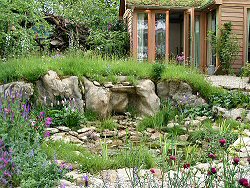 The pond and 'garden building' of the WT LUSH Garden. (View bigger image.)
The Wildlife Trusts' LUSH garden was one of the 'must see' gardens for me at this years show. In 2004 I had been very impressed by the garden they exhibited in the courtyard category (see The RHS Chelsea Flower Show 2004), but a garden in the show category is an altogether different proposition, representing a much greater investment in the promotion of wildlife gardening on the part of the Wildlife Trusts. The garden was one of a group of only three show gardens at Chelsea, stationed just below the BBC's nerve centre, that you had to join a queue to see. I joined the 'slow' stream so that I would be able to take my time at the garden and see it close up. It was worth the extra wait - The pond and 'garden building' of the WT LUSH Garden. (View bigger image.)
The Wildlife Trusts' LUSH garden was one of the 'must see' gardens for me at this years show. In 2004 I had been very impressed by the garden they exhibited in the courtyard category (see The RHS Chelsea Flower Show 2004), but a garden in the show category is an altogether different proposition, representing a much greater investment in the promotion of wildlife gardening on the part of the Wildlife Trusts. The garden was one of a group of only three show gardens at Chelsea, stationed just below the BBC's nerve centre, that you had to join a queue to see. I joined the 'slow' stream so that I would be able to take my time at the garden and see it close up. It was worth the extra wait -  the WT LUSH garden was a well designed and beautifully constructed the WT LUSH garden was a well designed and beautifully constructed the WT LUSH garden was a well designed and beautifully constructed. the WT LUSH garden was a well designed and beautifully constructed.
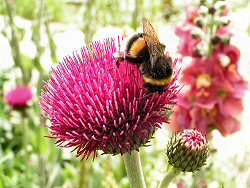 Thistle, Cirsium rivulare atropurpurea, with a light-tailed bumblebee (Bombus sp.).(View bigger image.) Thistle, Cirsium rivulare atropurpurea, with a light-tailed bumblebee (Bombus sp.).(View bigger image.)
The centrepiece was a wildlife pond (they called it a pool), which was a little bit different from most others I've seen, being quite rocky in construction and backed by large rocks about three foot in height. The rocks were an effective way of dealing with the problem of placing a pond in a garden that has a steep slope. A 'traditional' (though to my eyes quite contemporary) garden building vied with the pond for attention: it would be an amazing place from which to enjoy the garden in less clement weather.  The garden was, of course, packed with all sorts of wildlife-friendly features The garden was, of course, packed with all sorts of wildlife-friendly features The garden was, of course, packed with all sorts of wildlife-friendly features including an ambitious arch made from driftwood and a hibernaculum wall. The garden was, of course, packed with all sorts of wildlife-friendly features including an ambitious arch made from driftwood and a hibernaculum wall.
The planting was a successful mixture of native and cottage style planting, all done in a very naturalistic style. An impressive plant list included four ferns, 20 trees, over 80 herbaceous plants and 12 aquatic plants! The beautiful thistle Cirsium rivulare Atropurpurea, was planted at the front of the garden and immediately caught your attention as you walked past, not least because it was like a magnet to the bumblebees. This was one plant that I came away from the show thinking I must have for my own garden. The RHS awarded the garden a silver medal.
The Real Rubbish Garden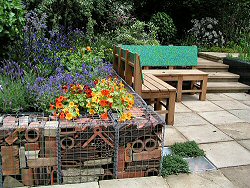 Recycling - the theme of the Real Rubbish Garden - was exemplified by 'croc' filled gabions used as a retaining wall for a raised bed. (View bigger image.)
Another 'must see' garden for me at this year's Chelsea Flower Show was the RSPB/SITA Environmental Trust Real Rubbish Garden. Recycling - the theme of the Real Rubbish Garden - was exemplified by 'croc' filled gabions used as a retaining wall for a raised bed. (View bigger image.)
Another 'must see' garden for me at this year's Chelsea Flower Show was the RSPB/SITA Environmental Trust Real Rubbish Garden.  The major theme of this garden was recycling: virtually material used within the garden was recycled one way or another The major theme of this garden was recycling: virtually material used within the garden was recycled one way or another The major theme of this garden was recycling: virtually material used within the garden was recycled one way or another. It was the ambition of the designers to have the greenest garden ever shown at Chelsea. This must have been just about the biggest garden at Chelsea - it seemed to go on forever. The plot was very generous and because of its shape and orientation (the longest side was bordered by the path from which it was viewed), the designers were able to take maximum advantage of its size. The major theme of this garden was recycling: virtually material used within the garden was recycled one way or another. It was the ambition of the designers to have the greenest garden ever shown at Chelsea. This must have been just about the biggest garden at Chelsea - it seemed to go on forever. The plot was very generous and because of its shape and orientation (the longest side was bordered by the path from which it was viewed), the designers were able to take maximum advantage of its size.
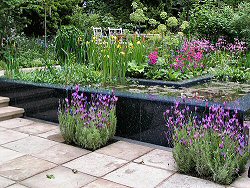 Formal raised pond in the Real Rubbish Garden. (View bigger image.)
Because of the garden's location within the grounds of the Royal Hospital, the RHS stipulated that the ground under this plot could not be broken. That constraint meant that the designers had to raise most of the planting areas and even the pond. This, perhaps, was the reason why the pond had a more formal design than we are used to seeing in gardens which show-case wildlife gardening. However, this was no bad thing - Formal raised pond in the Real Rubbish Garden. (View bigger image.)
Because of the garden's location within the grounds of the Royal Hospital, the RHS stipulated that the ground under this plot could not be broken. That constraint meant that the designers had to raise most of the planting areas and even the pond. This, perhaps, was the reason why the pond had a more formal design than we are used to seeing in gardens which show-case wildlife gardening. However, this was no bad thing -  I am always at pains to point out that wildlife gardening techniques need not be confined to gardens of a naturalistic idiom and features of this garden backed up that viewpoint I am always at pains to point out that wildlife gardening techniques need not be confined to gardens of a naturalistic idiom and features of this garden backed up that viewpoint I am always at pains to point out that wildlife gardening techniques need not be confined to gardens of a naturalistic idiom and features of this garden backed up that viewpoint. I am always at pains to point out that wildlife gardening techniques need not be confined to gardens of a naturalistic idiom and features of this garden backed up that viewpoint.
A retaining wall for a raised bed was built of small gabions filled with recycled crocs, paving slabs, tiles, pipes etc. This was a major feature of this garden and left an enduring impression. The small size of the gabions, which contrasted with larger gabions more normally seen in show gardens in recent years, left me with the impression that I could perhaps use them in my own garden. I'm sure many others went away with the same idea.
This large garden was packed with other wildlife-friendly features including a substantial meadow area, a shed with a turf-covered roof and a boundary wall made from the mother of all log piles! The RHS awarded the garden a silver medal.
The Trailfinders Recycled Garden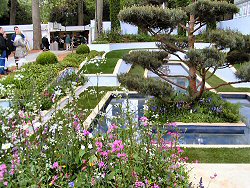 Looking at this classically designed garden, you would never has guessed that it was constructed wholly from recycled material. (View bigger image.)
This was a garden that seemed full of contradictions: Looking at this classically designed garden, you would never has guessed that it was constructed wholly from recycled material. (View bigger image.)
This was a garden that seemed full of contradictions:  the design was a formal classical design and yet virtually all the materials used to construct it were recycled the design was a formal classical design and yet virtually all the materials used to construct it were recycled the design was a formal classical design and yet virtually all the materials used to construct it were recycled. In contrast to the RSPB's Real Rubbish Garden though, the Trailfinders Recycled Garden did not 'boast' of its green credentials but rather hid them behind its renaissance design. the design was a formal classical design and yet virtually all the materials used to construct it were recycled. In contrast to the RSPB's Real Rubbish Garden though, the Trailfinders Recycled Garden did not 'boast' of its green credentials but rather hid them behind its renaissance design.
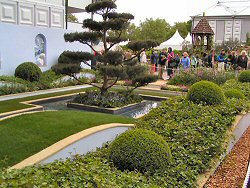 Imaginative use of native plants was a hallmark of this garden. Here box and Ivy form an undulating boundary. (View bigger image.)
This was a deliberate ploy: the message was that using recycled materials needn't dictate the design of the garden. The idiom chosen here was probably just about as far away as you can get from what you might typically expect to find in a 'recycled' garden. The overall design of this garden was not to my taste, but I could appreciate this message. Imaginative use of native plants was a hallmark of this garden. Here box and Ivy form an undulating boundary. (View bigger image.)
This was a deliberate ploy: the message was that using recycled materials needn't dictate the design of the garden. The idiom chosen here was probably just about as far away as you can get from what you might typically expect to find in a 'recycled' garden. The overall design of this garden was not to my taste, but I could appreciate this message.
For me the most delightful feature of this garden was the planting. This is, I think, the first show garden I've ever seen that relied wholly on native plants - a fact that is all the more remarkable given the formal design idiom. The plants were used imaginatively and effectively. Naturalistic beds contrasted with the formal design but there were also formally planted elements.  This garden was imaginative and, perhaps more than any other at Chelesa, thought provoking This garden was imaginative and, perhaps more than any other at Chelesa, thought provoking The most impressive was the undulating boundary down one side of the garden where ivy (Hedera helix) was used as a ground-cover plant, punctuated by box (Buxus sempervirens) topiary. This garden was imaginative and, perhaps more than any other at Chelesa, thought provoking - worthy of more than the bronze medal awarded by the RHS. The most impressive was the undulating boundary down one side of the garden where ivy (Hedera helix) was used as a ground-cover plant, punctuated by box (Buxus sempervirens) topiary. This garden was imaginative and, perhaps more than any other at Chelesa, thought provoking - worthy of more than the bronze medal awarded by the RHS.
The Fetzer Wine Garden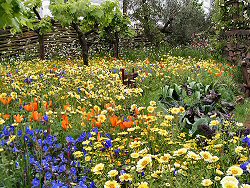 Californian and Mediterranean plants were used in this amazing drift planting. (View bigger image.)
This was an absolutely stunning garden and one of the most naturalistic designs at Chelsea. Some native British planting was included among extensive areas of plants from California and the Mediterranean. The stated aim of this garden was to 'inspire British gardeners to encourage wildlife in their gardens, and to use locally adapted plants and cover crops to feed the soil and provide a better habitat for beneficial insects and birds'. Californian and Mediterranean plants were used in this amazing drift planting. (View bigger image.)
This was an absolutely stunning garden and one of the most naturalistic designs at Chelsea. Some native British planting was included among extensive areas of plants from California and the Mediterranean. The stated aim of this garden was to 'inspire British gardeners to encourage wildlife in their gardens, and to use locally adapted plants and cover crops to feed the soil and provide a better habitat for beneficial insects and birds'.  The drift planting was awe inspiring and proved very attractive to visiting insects The drift planting was awe inspiring and proved very attractive to visiting insects The drift planting was awe inspiring and proved very attractive to visiting insects. The garden included a wetland area where a small pond was actually covered in duckweed (Lemna minor) - a first for me at Chelsea! Not so unusual was the inclusion of cow parsley (Anthriscus sylvestris), which cropped up in a number of show gardens this year. The drift planting was awe inspiring and proved very attractive to visiting insects. The garden included a wetland area where a small pond was actually covered in duckweed (Lemna minor) - a first for me at Chelsea! Not so unusual was the inclusion of cow parsley (Anthriscus sylvestris), which cropped up in a number of show gardens this year.
With the effects of global warming becoming more apparent as our summers become drier and warmer, some of the plants featured in this garden may well become more commonplace in our own gardens. The RHS awarded this garden a gold medal.
Moat and Castle Eco-Garden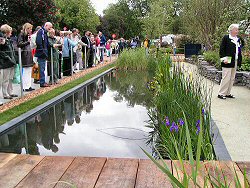 The amazing swimming pond. (View bigger image.)
This was The amazing swimming pond. (View bigger image.)
This was  an excellent example of a garden of the contemporary idiom which nevertheless embodied wildlife gardening principles an excellent example of a garden of the contemporary idiom which nevertheless embodied wildlife gardening principles an excellent example of a garden of the contemporary idiom which nevertheless embodied wildlife gardening principles. Its central and most striking feature was the 'swimming pond' which was a cross between swimming pool and wildlife pond. This was the first such feature ever to be shown at Chelsea. The concept was realised by using well delineated marginal shelves up one side and at one end of an elongated formal pond. The shelves housed the marginal plants which could act as a wildlife habitat and also serve to filter the water. The water beyond the shelves was deep enough to swim in. It was an excellent example of a garden of the contemporary idiom which nevertheless embodied wildlife gardening principles. Its central and most striking feature was the 'swimming pond' which was a cross between swimming pool and wildlife pond. This was the first such feature ever to be shown at Chelsea. The concept was realised by using well delineated marginal shelves up one side and at one end of an elongated formal pond. The shelves housed the marginal plants which could act as a wildlife habitat and also serve to filter the water. The water beyond the shelves was deep enough to swim in. It was  a nice concept, but in practice I suspect that the wash from swimmers would not be very conducive to a stable and rich wildlife habitat a nice concept, but in practice I suspect that the wash from swimmers would not be very conducive to a stable and rich wildlife habitat a nice concept, but in practice I suspect that the wash from swimmers would not be very conducive to a stable and rich wildlife habitat in the marginal planting. a nice concept, but in practice I suspect that the wash from swimmers would not be very conducive to a stable and rich wildlife habitat in the marginal planting.
Wildife was well served by the rest of the garden though. Soil excavated from the pond was used to build a raised meadow where native planting was the order of the day. Mature apple trees - excellent wildlife plants - provided a structural dimension. The RHS awarded this garden a silver medal.
The learning zone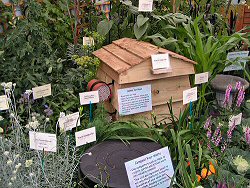 The Writtle College 'A Taste of the Wild' stand. (View bigger image.)
The learning zone is an excellent feature of the Chelsea Flower Show. A number of educational displays were featured together in the Great Pavilion. For me, The Writtle College 'A Taste of the Wild' stand. (View bigger image.)
The learning zone is an excellent feature of the Chelsea Flower Show. A number of educational displays were featured together in the Great Pavilion. For me,  this year's star of the learning zome was the stand of Writtle College entitled 'A Taste of the Wild' this year's star of the learning zome was the stand of Writtle College entitled 'A Taste of the Wild' this year's star of the learning zome was the stand of Writtle College entitled 'A Taste of the Wild'. It was, essentially, a stand all about wildlife gardening. Clearly labelled items showed everything from which plants to use to practically every conceivable bit of wildlife gardening 'kit' commercially available. There was even a small colony of bumblebees on display. Other notable stands included that of the Society for General Microbiology, themed on the relationship between plants and microbes. this year's star of the learning zome was the stand of Writtle College entitled 'A Taste of the Wild'. It was, essentially, a stand all about wildlife gardening. Clearly labelled items showed everything from which plants to use to practically every conceivable bit of wildlife gardening 'kit' commercially available. There was even a small colony of bumblebees on display. Other notable stands included that of the Society for General Microbiology, themed on the relationship between plants and microbes.
Summing up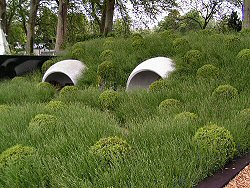 The Hanover Quay Garden. (View bigger image.)
Many other gardens at the show, apart from those mentioned here, contained elements of interest to the wildlife gardener. Others, like Diarmuid Gavin's Hanover Quay Garden, were just plain beautiful. This garden included an amazing lavender 'lawn' which, when in flower, would be a magnet to insects. Garden's like the Boreal Forest Garden and the 4head Garden, whilst not relying heavily on wildlife gardening techniques, nevertheless had some interesting things to say about gardens in relation to the wider environment. The Hanover Quay Garden. (View bigger image.)
Many other gardens at the show, apart from those mentioned here, contained elements of interest to the wildlife gardener. Others, like Diarmuid Gavin's Hanover Quay Garden, were just plain beautiful. This garden included an amazing lavender 'lawn' which, when in flower, would be a magnet to insects. Garden's like the Boreal Forest Garden and the 4head Garden, whilst not relying heavily on wildlife gardening techniques, nevertheless had some interesting things to say about gardens in relation to the wider environment.
All in all, the 2005 Chelsea Flower Show was big on environmental issues and wildlife gardening. Looking through the official catalogue for the show I see that no less than eight of the 19 show garden descriptions mention either wildlife or native wildflowers. This reflects the fact that  there is a rising public appetite for exploring the relationship between gardens and wildlife but, rather oddly, I don't see that appetite adequately reflected in the RHS establishment there is a rising public appetite for exploring the relationship between gardens and wildlife but, rather oddly, I don't see that appetite adequately reflected in the RHS establishment there is a rising public appetite for exploring the relationship between gardens and wildlife but, rather oddly, I don't see that appetite adequately reflected in the RHS establishment itself. Otherwise I am at a loss to explain why gardens like the RSPB SITA Real Rubbish Garden and the Wildlife Trust LUSH Garden were only awarded silver medals; both appeared to me to be worthy of better. Don't get me wrong, personally I don't give a hoot about medals (it's vulgar to judge art in that way in my opinion), but it is what that says about the position of the horticultural establishment that bothers me. there is a rising public appetite for exploring the relationship between gardens and wildlife but, rather oddly, I don't see that appetite adequately reflected in the RHS establishment itself. Otherwise I am at a loss to explain why gardens like the RSPB SITA Real Rubbish Garden and the Wildlife Trust LUSH Garden were only awarded silver medals; both appeared to me to be worthy of better. Don't get me wrong, personally I don't give a hoot about medals (it's vulgar to judge art in that way in my opinion), but it is what that says about the position of the horticultural establishment that bothers me.
| First published June 2005. Last revised August 2005. | |
Copyright Richard Burkmar 2005. Permission is hereby granted for anyone to use this article for non-commercial purposes which are of benefit to the natural environment as long the original author is credited. School pupils, students, teachers and educators are invited to use the article freely. Use for commercial purposes is prohibited unless permission is obtained from the copyright holder. |
Back to home page
Do you live in Merseyside? Interested in its wildlife? |